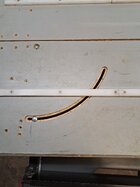You’re trying to do the same thing, but the order of operations will foul your proposals. The parenthesis's are needed to be correct.
Tim
For the subtraction, you are correct, I missed that in my OP. However all the rest of the parentheses are not necessary. This can easily enough be proven:
R = 22.75
L = 5.25
T = 0.445
B = 0.423
My Original:
A = (T-B)/4/L*R
= (0.445-0.423)/4/5.25*22.75
= 0.022/4/5.25*22.75
= 0.0055/5.25*22.75
= 0.00105*22.75
= 0.0238
Yours:
A = ((T-B)/4)*(R/L))
= ((0.445-0.423)/4)*(22.75/5.25))
= ((0.022/4)*4.333)
= 0.0055*4.33
= 0.238
The excess of parentheses kind of gets in the way, IMO. Basic order of operations for simple terms means multiplication/division have higher precedence than addition/subtraction, otherwise you run left to right. It doesn't matter if you move the /4 as a 1/4 * (R/L) even. The results are still the same:
A = ((T-B)*((R/L)/4))
= ((0.445-0.423)*((22.75/5.25)/4))
= (0.022*(4.333/4))
= 0.022*1.08333
= 0.238
Or we could even do this, running the M/D left to right:
A = ((T-B) * (R/L) / 4)
= ((0.445-0.423) * (22.75/5.25) / 4)
= (0.022*4.333 / 4)
= 0.095333/4
= 0.238
I forgot the parens for T-B originally, but once that's added, you can use simple algebra to rearrange the formula between my version and you version simply enough. The (T-B)/4/L is really (T-B)/4 * 1/L. Once you have the 1/L term, multiplying by R gives you R/L. You can easily enough seprate that into R/1 * 1/L, and combine the L back with the original (T-B)/4 term... I think it keeps things simpler, if you limit the number of parens (as, technically, "parenthesized/bracketed" groups take the single highest precedence, meaning you have to expend more cognitive effort to parse through the formula with all the parens. Keeping the parens around just the one term that actually needs a bump in precedence, (T-B), it keeps the cognitive effort lower.

PEMDAS, is the acronym, right? Parentheses, Exponents, Multiplication/Division (equal precedence, run left to right), Addition/Subtraction (equal precedence, run left to right). I think there is another acronym, BODMAS, which is basically the same thing. Technically they can both be reduced to PEMA/BOMA, since division is multiplication by a fraction, and subtraction is addition of a negative number. In any case...thanks for pointing out I missed the parens on the subtraction, that DID need to be done first.
This is what I meant about the 5 cut method being fiddly. I kept getting confused and adjusting the fence in the wrong direction. The 3 cut method provides an intuitively obvious visual of the magnitude and direction of the fence correction required even to a foggy brain like mine.
If you give yourself a simple rule, its easier:
Negative -> Move Inward (swing end of fence moves into sled)
Positive -> Move Outward (swing end of fence moves out of sled)
Then it becomes less fiddly, at least math and concept wise.
For me, the frustration has been, it seems like even a little flex in the system screws the pooch.
I'm all for simpler, though. I started watching videos on the 3-cut method... I'll have to run through them again. Effort wise, I don't know if I'm convinced its easier? Mathematically, there is less math, but...I'm good with math usually, so the 5-cut method works for me. This guy had a pretty good video...is this the same method you are referring to?
View: https://www.youtube.com/watch?v=2l5DFlCRGKo

